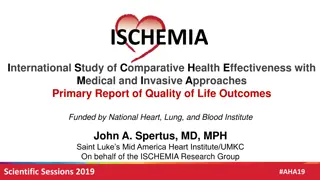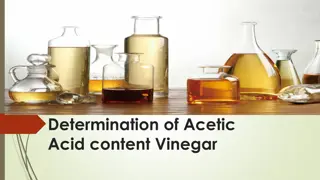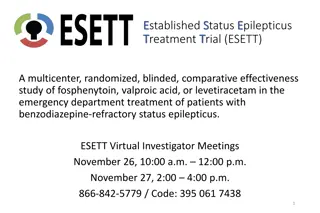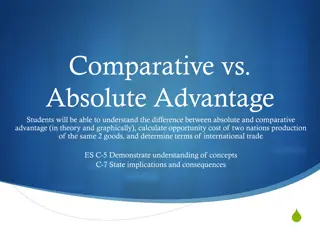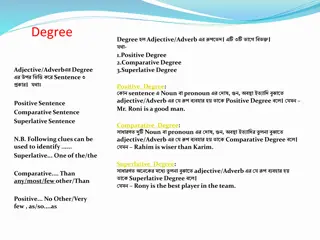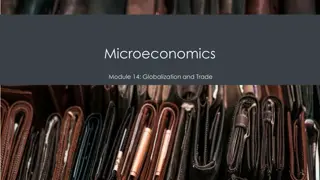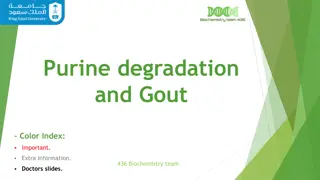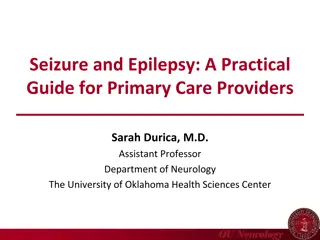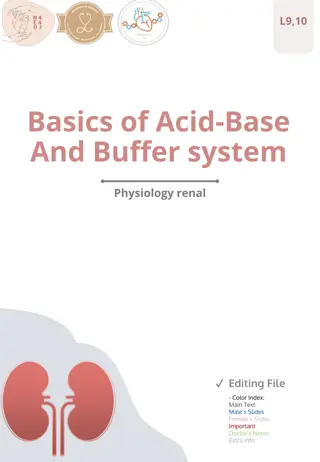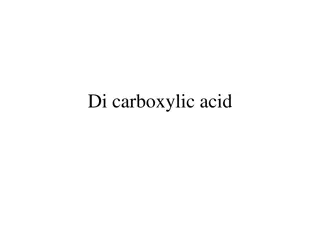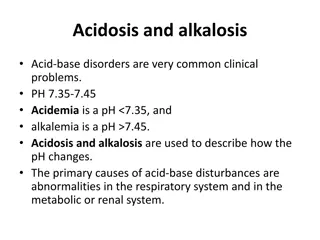Comparative Effectiveness Study of Fosphenytoin, Valproic Acid, and Levetiracetam in Status Epilepticus Treatment
The ESETT study is a comparative effectiveness trial evaluating fosphenytoin, valproic acid, and levetiracetam in treating benzodiazepine-refractory status epilepticus. The goal is to determine the most effective among these agents while assessing safety outcomes. Inclusion criteria focus on patients with witnessed seizures within a specific time frame and who received benzodiazepines. An Exception from Informed Consent is applied due to the urgency and severity of the condition.
Download Presentation

Please find below an Image/Link to download the presentation.
The content on the website is provided AS IS for your information and personal use only. It may not be sold, licensed, or shared on other websites without obtaining consent from the author. Download presentation by click this link. If you encounter any issues during the download, it is possible that the publisher has removed the file from their server.
E N D
Presentation Transcript
E Established S Status E Epilepticus T Treatment T Trial (ESETT) A multicenter, randomized, blinded, comparative effectiveness study of fosphenytoin, valproic acid, or levetiracetam in the emergency department treatment of patients with benzodiazepine-refractory status epilepticus. ESETT Virtual Investigator Meetings November 26, 10:00 a.m. 12:00 p.m. November 27, 2:00 4:00 p.m. 866-842-5779 / Code: 395 061 7438 1
ESETT Virtual Investigator Meeting Agenda November 26 and 27 Start End Item Presenter Monday, November 26, 10:00-12:00 10:00 AM 10:05 AM Welcome 10:05 AM 11:05 AM Protocol Adherence Dr. Kapur, Dr. Chamberlain, Dr. Silbergleit 11:05 AM 11:25 AM PK/PD Training Lisa Coles 11:25 AM 11:40 AM Screening Best Practices Ima Samba (CHOP), Maha Khalil (Texas Children's) 11:40 AM 12:00 PM Ongoing Training of Clinical Staff and Study Team Joy Black, Lindsey Harris Tuesday November 27, 2:00-4:00 2:00 PM 2:05 PM Welcome 2:05 PM 3:05 PM Protocol Adherence Dr. Kapur, Dr. Chamberlain, Dr. Silbergleit 3:05 PM 3:25 PM PK/PD Training Lisa Coles 3:25 PM 3:40 PM Screening Best Practices Ima Samba (CHOP), Maha Khalil (Texas Children's) 3:40 PM 4:00 PM Ongoing Training of Clinical Staff and Study Team Joy Black, Lindsey Harris
Synopsis 150,000 Episodes of Status Epilepticus 30% continue to seizure after benzodiazepines Best second line agents unknown Three agents are commonly used Fosphenytoin (FOS) 20 mg/Kg Levetiracetam (LEV) 40 mg/Kg Valproic acid (VPA) 60 mg/Kg
Goal To determine the most effective or the least effective agent among three most commonly used drugs. Determine rate of safety events: life-threatening hypotension or cardiac arrhythmia. Other secondary outcomes
Inclusion Criteria Inclusion criteria Measure Patient witnessed to have a seizure in the past 5-30 minutes. Time of first seizure is when EMS personnel were called if eyewitness account available or first seizure witnessed by EMS personnel. Patient received adequate dose of benzodiazepines in the past 5-30 minutes. EMS or ED record of treatment: For those > 40 kg--diazepam 10 mg IV or rectal, lorazepam 4 mg, IV, or midazolam 10 mg IM or IV. The doses may be divided. Time is counted from the last dose. For those 10-40 Kg adequate doses are: diazepam 0.3 mg/kg IV or rectal, lorazepam 0.1 mg/kg IV or midazolam 0.3 mg/kg IM or 0.2 mg/Kg IV Continueded seizure in the Emergency Department Clinical observation Age more than 2 years Caretakers report the age or clinical observation 5
Exception From Informed Consent Justification: Convulsive status epilepticus is a life threatening disease Best available treatment is unproven Clinical trials are needed Obtaining prospective informed consent is not feasible Subject altered (actively seizing and unconscious) An acute seizing patient cannot be identified prospectively LAR is often not available in the short time frame required. Even when an LAR is available, meaningful informed consent is impossible to obtain because of the time constraints and the emotional distress caused by witnessing convulsive SE. Subjects may benefit from the research Research could not be carried out without EFIC Therapeutic window too short 6
Primary Outcome Clinical cessation of status epilepticus, determined by the absence of clinically apparent seizures and improving responsiveness, at 60 minutes after the start of study drug infusion, without the use of additional anti-seizure medication. (*Note if patient is intubated within 60 minutes of enrollment, it is failure to meet primary outcome, because sedatives are used) 8
Other Outcomes Safety outcomes Life-threatening hypotension: Life-threatening cardiac arrhythmia: Secondary o Richmond agitation and sedation score at primary outcome determination o Time to termination of seizures o Intubation, o Admission to ICU o Seizure recurrence o Length of stay in the ICU and hospital, o Mortality 9
Benzodiazepines : dose vs AES guidelines
Cumulative dose in Lorazepam equivalents
Small dose safer or more dangerous? Do benzos cause cardio respiratory compromise? However PHTSE trial data suggest that under- treatment is more dangerous. Cardio-respiratory compromise 25 p=0.08 % Subjects (PHTSE) 20 15 10 5 0 Placebo Lorazepam (4 mg) Diazepam (10 mg) N Engl J Med. 2001 Aug 30;345(9):631-7.
Preventing near misses Modified ESETT app on Protocol assist device. Cards available to fix on top study box. Increased awareness of the protocol
GTCS > 5 minutes Psychogenic non epileptic seizures: if the chart has this diagnosis/ you know that they have PNES. Focal seizures.
Emergency Unblinding Ongoing or recurrent status Plan to use one of the study drugs as next agent We will ask to speak to treating physician Preferred options: Aggressive use of third line agent General anesthesia Phenobarbital Midazolam drip Others 18
Accrual tracking You can always see up to the minute accrual data at: nett.umich.edu/nett-resources/dashboard or go to nett.umich.edu and click on enrollment dashboard
Acknowledgments ESETT collaborators: Gerhard Bauer, Lea Becker, Tom Bleck, Erin Bengelik, John Betjemann, Joy Black, Hannah Cock, Cassidy Connor, Jason Connor , Jim Chamberlain, Jim Cloyd, Lisa Coles, Catherine Dillon, Jordan Elm, Amy Fansler, Nathan Fountain, Brandy Fureman, Emily Gray, Deneil Harney, Christina Hill, Steve Huff, Karen Johnston, Elizabeth Jones, Brian Kelley, Brian Litt, Dan Lowenstein, Arthi Ramakrishnan, Shlomo Shinnar, Kate Shreve, Robert Silbergleit, Valerie Stevenson, David Treiman, Eugen Trinka. Lab Colleagues Doug Borris, John Williamson, Jianli Sun, Zakaria Mtchedlishvilli Chengsan Sun, Karthik Rajasekaran, Suchitra Joshi, Howard Goodkin, Edward Bertram, Brandon Martin, Marko Todorovic, Jianli Sun, Natalia Dabrowska, Ashley Renick, Catherine Swanwick, Mmatt Rannals Funding: NINDS, Counter-Act program (NIH), Congressionally- Directed Medical Research Program (CDMRP) of the Department of Defense, Epilepsy Foundation, CURE Epilepsy Foundation.
Essential Knowledge Game! East of the Mississippi vs West of the Mississippi
SAE Reporting Consider the following 3 versions of an SAE narrative. After all 3 are shown, choose the version that is most consistent with ESETT training on preferred reporting of SAE narratives .
Version A Respiratory Depression A 35 yo with complex psychiatric history and prior alcohol related seizures had stuttering status epilepticus, received midazolam 10 mg and lorazepam 2 mg in divided doses over 2 hours, and enrolled on 2/8/17 at 23:01, followed by an aspiration event and transient hypoxia. He stopped seizing but remained poorly responsive. He was endotracheally intubated at 23:25 for airway protective and decreased level of consciousness and risk of further aspiration. He was sedated with propofol and admitted to ICU. Normal CXR and no sequelae of aspiration on 2/9/17. Extubated on 2/10/17.
Version B Respiratory Depression 35 y.o. male with a history of anxiety, bipolar affective disorder, schizophrenia, and previous seizure event thought to be EtOH related presented to enrolling center ED via EMS 2/8/17 at 20:47 with seizures. Seizure in route abated with 4mg midazolam IM EMS administered. On initial assessment patient was sedated, but responded to noxious stimuli. Sedation thought to be due to EtOH, versed, and post-ictal state. Labs and CT head ordered. In CT patient had repeat seizure. He was given midazolam 3 mg IM and was brought back to ER. He appeared to continue to be having seizure so additional midazolam 3 mg IV was given. Seizure appeared to resolve. Neurology consulted to ER. Patient return of seizures occurred at approximately 2240. He was given an additional lorazepam 2 mg IV. Seizure continued for 5 minutes so ESETT drug was given. Study drug infusion started at 23:01. During infusion, pt appeared to have aspiration event. Infusion completed and patient stopped seizing and withdrew from nailbed pressure. At 20 minute assessment he was still responding to noxious stimulation. He was intubated for airway protection due to apparent aspiration event. He was sedated with propofol post intubation. Pt was admitted to the ICU for further diagnosis and management. 60 minute assessment at 00:15 revealed pt was sedated but withdrew from nailbed pressure. On 2/10/17 about 13:15 he was electively extubated. 2/10/17 1900 many verbally aggressive outbursts noted. 2/11/17 09:03 patient left AMA, after psychiatric evaluation
Version C Respiratory Depression A patient stopped seizing but remained poorly responsive and so got intubated. He went to the ICU and ultimately did ok. He had respiratory depression.
Consider the following 3 versions of an SAE narrative. After all 3 are shown, choose the version Consider the following 3 versions of an SAE narrative. After all 3 are shown, choose the version that is most consistent with ESETT training on preferred reporting of SAE narratives . that is most consistent with ESETT training on preferred reporting of SAE narratives . Version A Respiratory Depression A 35 yo with complex psychiatric history and prior alcohol related seizures had stuttering status epilepticus, received midazolam 10 mg and lorazepam 2 mg in divided doses over 2 hours, and enrolled on 2/8/17 at 23:01, followed by an aspiration event and transient hypoxia. He stopped seizing but remained poorly responsive. He was endotracheally intubated at 23:25 for airway protective and decreased level of consciousness and risk of further aspiration. He was sedated with propofol and admitted to ICU. Normal CXR and no sequelae of aspiration on 2/9/17. Extubated on 2/10/17. Version B Respiratory Depression 35 y.o. male with a history of anxiety, bipolar affective disorder, schizophrenia, and previous seizure event thought to be EtOH related presented to enrolling center ED via EMS 2/8/17 at 20:47 with seizures. Seizure in route abated with 4mg midazolam IM EMS administered. On initial assessment patient was sedated, but responded to noxious stimuli. Sedation thought to be due to EtOH, versed, and post-ictal state. Labs and CT head ordered. In CT patient had repeat seizure. He was given midazolam 3 mg IM and was brought back to ER. He appeared to continue to be having seizure so additional midazolam 3 mg IV was given. Seizure appeared to resolve. Neurology consulted to ER. Patient return of seizures occurred at approximately 2240. He was given an additional lorazepam 2 mg IV. Seizure continued for 5 minutes so ESETT drug was given. Study drug infusion started at 23:01. During infusion, pt appeared to have aspiration event. Infusion completed and patient stopped seizing and withdrew from nailbed pressure. At 20 minute assessment he was still responding to noxious stimulation. He was intubated for airway protection due to apparent aspiration event. He was sedated with propofol post intubation. Pt was admitted to the ICU for further diagnosis and management. 60 minute assessment at 00:15 revealed pt was sedated but withdrew from nailbed pressure. On 2/10/17 about 13:15 he was electively extubated. 2/10/17 1900 many verbally aggressive outbursts noted. 2/11/17 09:03 patient left AMA, after psychiatric evaluation Version C Respiratory Depression A patient stopped seizing but remained poorly responsive and so got intubated. He went to the ICU and ultimately did ok. He had respiratory depression.
ESETT ESETT Pharmacokinetic Pharmacokinetic- -Pharmacodynamic (PK/PD) Study (PK/PD) Study Pharmacodynamic ESETT Investigators Meeting November 26th and 27th, 2018
ESETT PK/PD Study ESETT PK/PD Study Determine whether drug concentrations help explain responses (seizure cessation/AEs). Aim: Relate drug exposure with seizure cessation and the key secondary outcomes. Outcomes: Better understand the results from ESETT. Provide guidance on how best to use FOS, LEV, and VPA for treatment of SE in children.
Study Progress Study Progress 26 subjects enrolled 15/20 ESETT enrollments THANK YOU!
Reasons for Missed Enrollments Reasons for Missed Enrollments Communication (8%) Laboratory (17%) Consenting (40%) Site Participation (25%) Blood Collection (33%)
Overview of Study Procedures Overview of Study Procedures Measure the patient s height Collect two blood samples (2.5-3 mL/sample) One sample between 20-50 min and a second sample between 60-120 min from the start of drug infusion Record exact blood collection time If unable to collect sample within window, draw sample when possible. enrollment/ randomization 00:00 00:60 00:10 00:20 00:50 02:00 1 blood collection 1 blood collection study drug infusion observe
Consenting Considerations Consenting Considerations A few instances where LAR declined the first or second blood collection. pediatric patient unconscious/seizing* conscious 2nd IV* no 2nd IV obtain approval* * collect sample
A Few Reminders A Few Reminders If the first blood sampling window is missed, please take 2 samples in the second window. If you can only obtain 1 sample, please collect it. Fill out ESETT PK/PD eCRF for every ESETT subject. Ship samples to CODR when convenient should be shipped following the completion of up to 4 subjects or every 6 months, whichever comes first.
Frequently Asked Questions Frequently Asked Questions Can blood drawn from a site used to deliver fluids or other study medication be used? Answer: Yes. Blood can be drawn from any site NOT used for study drug infusion. What should I do if we obtain the blood sample outside of the sampling time window? Answer: The data from this sample can still be used. Record the actual time that the sample was collected on the PK blood collection eCRF and process and ship that sample as specified.
Frequently Asked Questions (Cont.) Frequently Asked Questions (Cont.) What should I do if the volume of blood collected is less than 2.5 mL? Answer: The sample will still be used. Process and ship the sample as specified. What should I do if the blood sample is centrifuged greater than 2 hrs after sample collection? Answer: Record the procedural deviation under Question 8 of the PK/PD eCRF.
Contacts Contacts ESETT PK/PD study team at esett-pkpd@umich.edu Lisa Coles at 612-624-1861 (office) or durh0016@umn.edu James Cloyd at 612-624-4609 (office) References Manual of Procedures 1 page quick guide
Thanks Again and Questions Thanks Again and Questions
CHOP | ESETT Screening CHOP | ESETT Screening RCs/RAs stagger work day schedules to maximize ESETT coverage from 8:00 am to 8:00 pm on weekdays. Enrollment only occurs when RCs/RAs are present. Early RC/RA turns on ESETT. Late RC/RA turns off ESETT. Academic associates screen patients who present to the ED with seizures from 7:00 am to 12:00 am on weekdays and weekends, as an extension of ESETT EFIC consultation activities. Academic associates alert RCs/RAs of actively seizing patients in the ED.
CHOP | ESETT Missed Eligible Tracking CHOP | ESETT Missed Eligible Tracking Missed eligibles are tracked via Business Object Reports in the EMR, allowing us to review all patients who present to the ED with chief complaints indictive of seizure or status epilepticus. NCT03754114
ESETT screening Texas Childrens Hospital Excluded 1=Excluded list 2=Previously enrolled 3=Pregnancy 4=Prisoner 5=Tx w/ 2nd line anticonvulsant 6=Sedated 7=Intubated 8=Acute TBI 9=Metabolic disorder 10=Liver dz 11=Renal dz 12=Allergy/Contraindication 13=Hypo/hyperglycemia 14=Cardiac arrest/anoxia If No, document all of the inclusion criteria the pt did NOT meet. If RC was present, did sz cessation occur prior to study drug administration? Keppra, FOS or VPA? Study ID / Randomization No. RC Present Enrolled Meet all Inclusion criteria? (Y or N) Date of Visit Name MRN CSN Comment 1 = Age <2 or >17 2 = Not generalized convulsive sz (e.g. Focal sz) 3 = Seizure < 5 min in duration 4 = Did not receive adequate dose of benzo 5 = Last benzo > 30 mins (Y, N or N/A) (Y, N or N/A) (Y or N) (Y, N or N/A) Helps identify trends in exclusion criteria and reasons not enrolled Missed eligible Inadequate benzos Education/awareness initiatives (RCs & clinicians)
Protocol Assist Device Reminders 1. Do not turn off device in the middle of an enrollment! The recording stops while the screen is turned off even though the timer does not.
Protocol Assist Device Reminders 2. Regularly check device for charge level! Make sure the device is charged and ready after each enrollment. Check the battery level every 2-4 weeks. Note: Colder temperatures may give a false battery reading when the device is first turned on. Allow it to warm up before assessing its need for charge.
Protocol Assist Device Reminders 3. Update iOS software when available! Be sure your software is up to date by installing updates when they are available. For assistance with iOS updates, please contact Lindsey (liha@umich.edu). Software updates can be found under Settings > General > Software Update.
Protocol Assist Device Reminders 4. Further information about the Protocol Assist Device can be found in the User Manual, link in the ESETT website toolbox.
Clinical Summary Packet Reminders 1. The Clinical Summary Packets should include the following documents: Summary Packet cover page Ambulance run sheet Complete ED chart (including ED chart from referring hospital if patient was transferred) Admission note/H&P Initial neurology consult note (if different from admission note) Reports of any brain CT, brain MRI and all EEG if obtained. Full Discharge summary not just patient discharge instructions
Clinical Summary Packet Reminders 2. All electronic health records should be printed directly to pdf. If possible, do not print paper copies and scan them back into an electronic record.
Clinical Summary Packet Reminders 2. All references to study drug assignment/dosing and patient PHI must be electronically redacted. Redaction instructions and CRF completion guidelines can be found in the ESETT website toolbox.
ESETT Clinical Team Training Materials Available at ESETT.org under Clinicians Only (no login required!) ESETT Minutes Enrollment Dosing SE in the ED Videos Feel free to share all materials under Study Team Section (login required)







